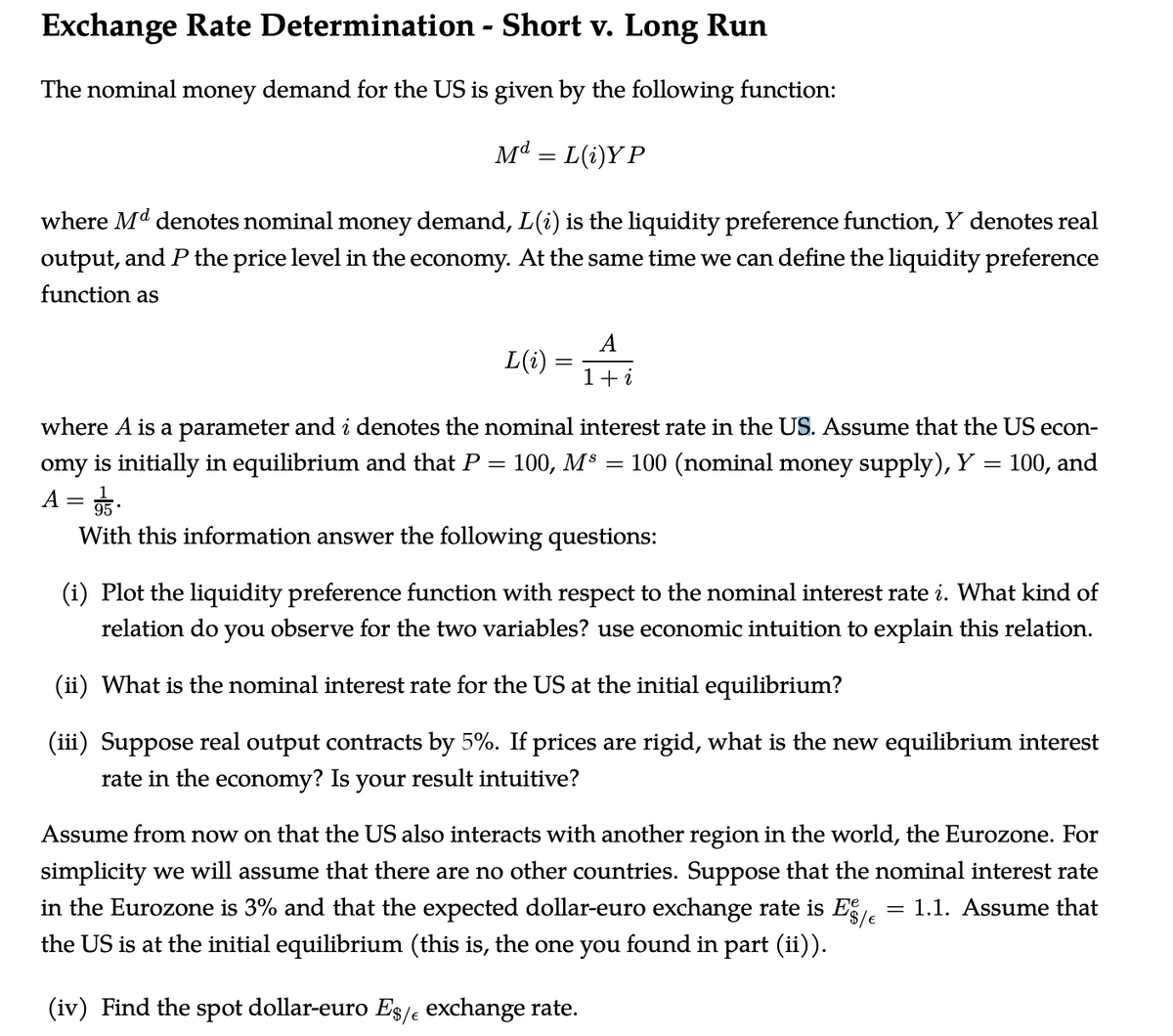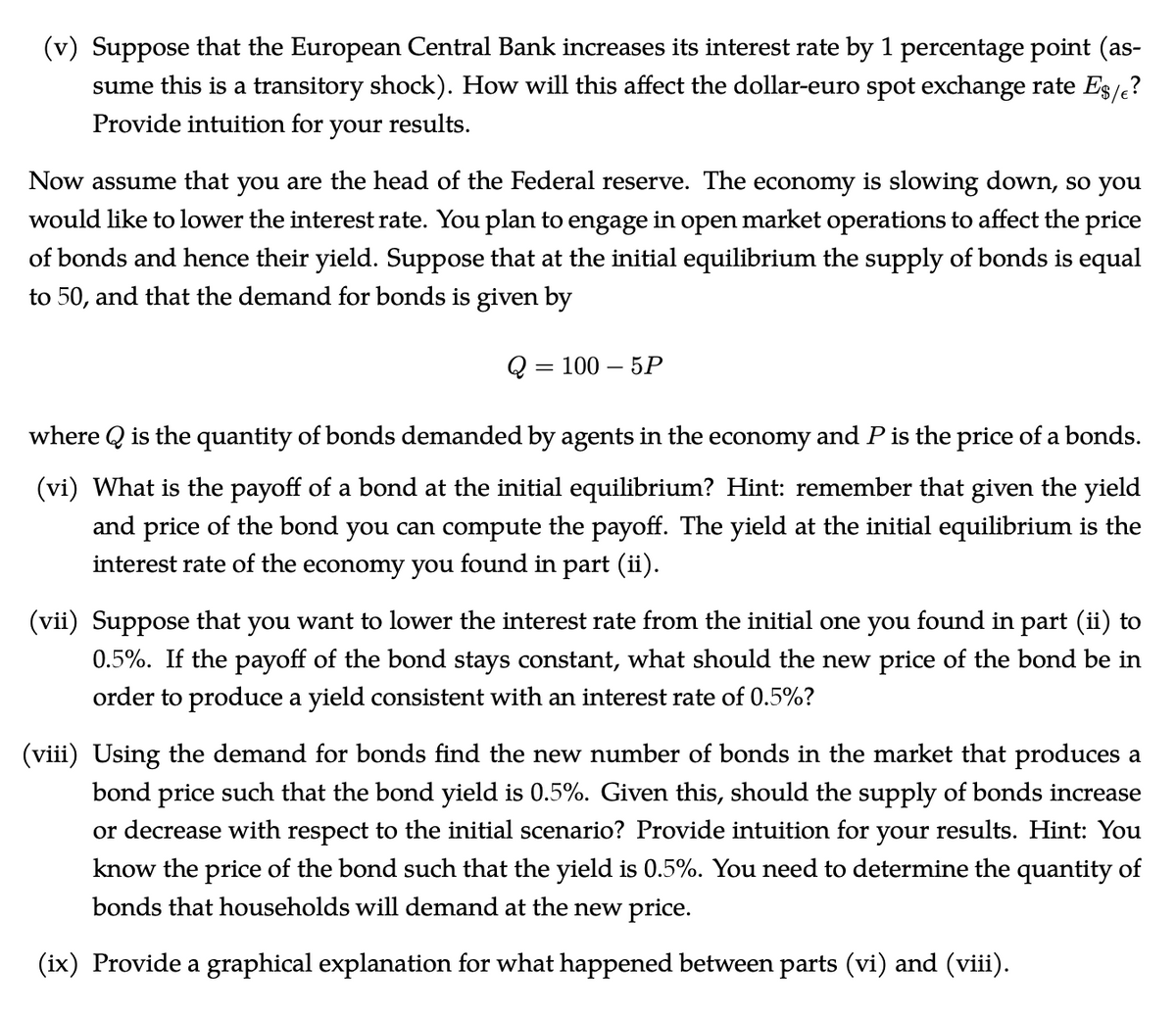Exchange Rate Determination - Short v. Long Run The nominal money demand for the US is given by the following function: Mª = L(i)Y P where Md denotes nominal money demand, L(i) is the liquidity preference function, Y denotes real output, and P the price level in the economy. At the same time we can define the liquidity preference function as A L(i) 1+i where A is a parameter and i denotes the nominal interest rate in the US. Assume that the US econ- omy is initially in equilibrium that P = 100, M³ = 100 (nominal money supply), Y = 100, and A = With this information answer the following questions: (i) Plot the liquidity preference function with respect to the nominal interest rate i. What kind of relation do you observe for the two variables? use economic intuition to explain this relation. (ii) What is the nominal interest rate for the US at the initial equilibrium? (iii) Suppose real output contracts by 5%. If prices are rigid, what is the new equilibrium interest
Exchange Rate Determination - Short v. Long Run The nominal money demand for the US is given by the following function: Mª = L(i)Y P where Md denotes nominal money demand, L(i) is the liquidity preference function, Y denotes real output, and P the price level in the economy. At the same time we can define the liquidity preference function as A L(i) 1+i where A is a parameter and i denotes the nominal interest rate in the US. Assume that the US econ- omy is initially in equilibrium that P = 100, M³ = 100 (nominal money supply), Y = 100, and A = With this information answer the following questions: (i) Plot the liquidity preference function with respect to the nominal interest rate i. What kind of relation do you observe for the two variables? use economic intuition to explain this relation. (ii) What is the nominal interest rate for the US at the initial equilibrium? (iii) Suppose real output contracts by 5%. If prices are rigid, what is the new equilibrium interest
Managerial Economics: Applications, Strategies and Tactics (MindTap Course List)
14th Edition
ISBN:9781305506381
Author:James R. McGuigan, R. Charles Moyer, Frederick H.deB. Harris
Publisher:James R. McGuigan, R. Charles Moyer, Frederick H.deB. Harris
Chapter6: Managing In The Global Economy
Section: Chapter Questions
Problem 4E
Related questions
Question
Can you solve parts 7-9
Interest rate from part 2 is 5.263%

Transcribed Image Text:Exchange Rate Determination - Short v. Long Run
The nominal money demand for the US is given by the following function:
Md = L(i)Y P
where Md denotes nominal money demand, L(i) is the liquidity preference function, Y denotes real
output, and P the price level in the economy. At the same time we can define the liquidity preference
function as
A
L(i)
1+i
where A is a parameter and i denotes the nominal interest rate in the US. Assume that the US econ-
omy is initially in equilibrium and that P = 100, M³
A = .
With this information answer the following questions:
100 (nominal money supply), Y = 100, and
(i) Plot the liquidity preference function with respect to the nominal interest rate i. What kind of
relation do you observe for the two variables? use economic intuition to explain this relation.
(ii) What is the nominal interest rate for the US at the initial equilibrium?
(iii) Suppose real output contracts by 5%. If prices are rigid, what is the new equilibrium interest
rate in the economy? Is your result intuitive?
Assume from now on that the US also interacts with another region in the world, the Eurozone. For
simplicity we will assume that there are no other countries. Suppose that the nominal interest rate
in the Eurozone is 3% and that the expected dollar-euro exchange rate is E
the US is at the initial equilibrium (this is, the one you found in part (ii)).
= 1.1. Assume that
(iv) Find the spot dollar-euro Eş/e exchange rate.

Transcribed Image Text:(v) Suppose that the European Central Bank increases its interest rate by 1 percentage point (as-
sume this is a transitory shock). How will this affect the dollar-euro spot exchange rate Es/.?
Provide intuition for
your results.
Now assume that you are the head of the Federal reserve. The economy is slowing down, so you
would like to lower the interest rate. You plan to engage in open market operations to affect the price
of bonds and hence their yield. Suppose that at the initial equilibrium the supply of bonds is equal
to 50, and that the demand for bonds is given by
Q = 100 – 5P
where Q is the quantity of bonds demanded by agents in the economy and Pis the price of a bonds.
(vi) What is the payoff of a bond at the initial equilibrium? Hint: remember that given the yield
and price of the bond you can compute the payoff. The yield at the initial equilibrium is the
interest rate of the economy you found in part (ii).
(vii) Suppose that
you want to lower the interest rate from the initial one you found in part (ii) to
0.5%. If the payoff of the bond stays constant, what should the new price of the bond be in
order to produce a yield consistent with an interest rate of 0.5%?
(viii) Using the demand for bonds find the new number of bonds in the market that produces a
bond price such that the bond yield is 0.5%. Given this, should the supply of bonds increase
or decrease with respect to the initial scenario? Provide intuition for your results. Hint: You
know the price of the bond such that the yield is 0.5%. You need to determine the quantity of
bonds that households will demand at the new price.
(ix) Provide a graphical explanation for what happened between parts (vi) and (viii).
Expert Solution
This question has been solved!
Explore an expertly crafted, step-by-step solution for a thorough understanding of key concepts.
This is a popular solution!
Trending now
This is a popular solution!
Step by step
Solved in 2 steps with 1 images

Knowledge Booster
Learn more about
Need a deep-dive on the concept behind this application? Look no further. Learn more about this topic, economics and related others by exploring similar questions and additional content below.Recommended textbooks for you

Managerial Economics: Applications, Strategies an…
Economics
ISBN:
9781305506381
Author:
James R. McGuigan, R. Charles Moyer, Frederick H.deB. Harris
Publisher:
Cengage Learning

Macroeconomics: Private and Public Choice (MindTa…
Economics
ISBN:
9781305506756
Author:
James D. Gwartney, Richard L. Stroup, Russell S. Sobel, David A. Macpherson
Publisher:
Cengage Learning

Economics: Private and Public Choice (MindTap Cou…
Economics
ISBN:
9781305506725
Author:
James D. Gwartney, Richard L. Stroup, Russell S. Sobel, David A. Macpherson
Publisher:
Cengage Learning

Managerial Economics: Applications, Strategies an…
Economics
ISBN:
9781305506381
Author:
James R. McGuigan, R. Charles Moyer, Frederick H.deB. Harris
Publisher:
Cengage Learning

Macroeconomics: Private and Public Choice (MindTa…
Economics
ISBN:
9781305506756
Author:
James D. Gwartney, Richard L. Stroup, Russell S. Sobel, David A. Macpherson
Publisher:
Cengage Learning

Economics: Private and Public Choice (MindTap Cou…
Economics
ISBN:
9781305506725
Author:
James D. Gwartney, Richard L. Stroup, Russell S. Sobel, David A. Macpherson
Publisher:
Cengage Learning